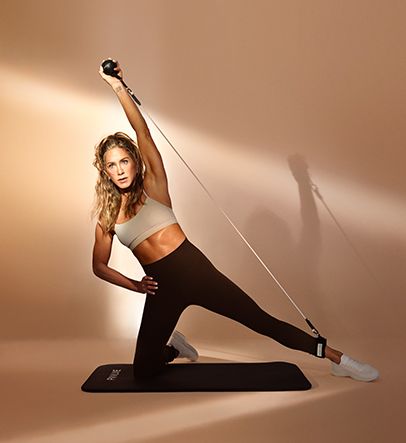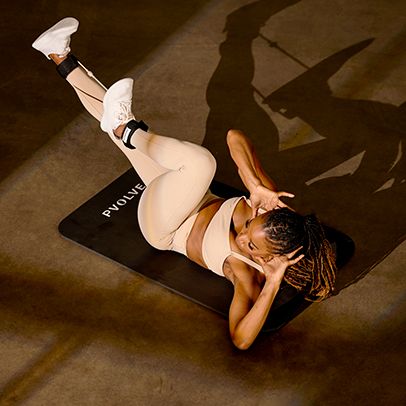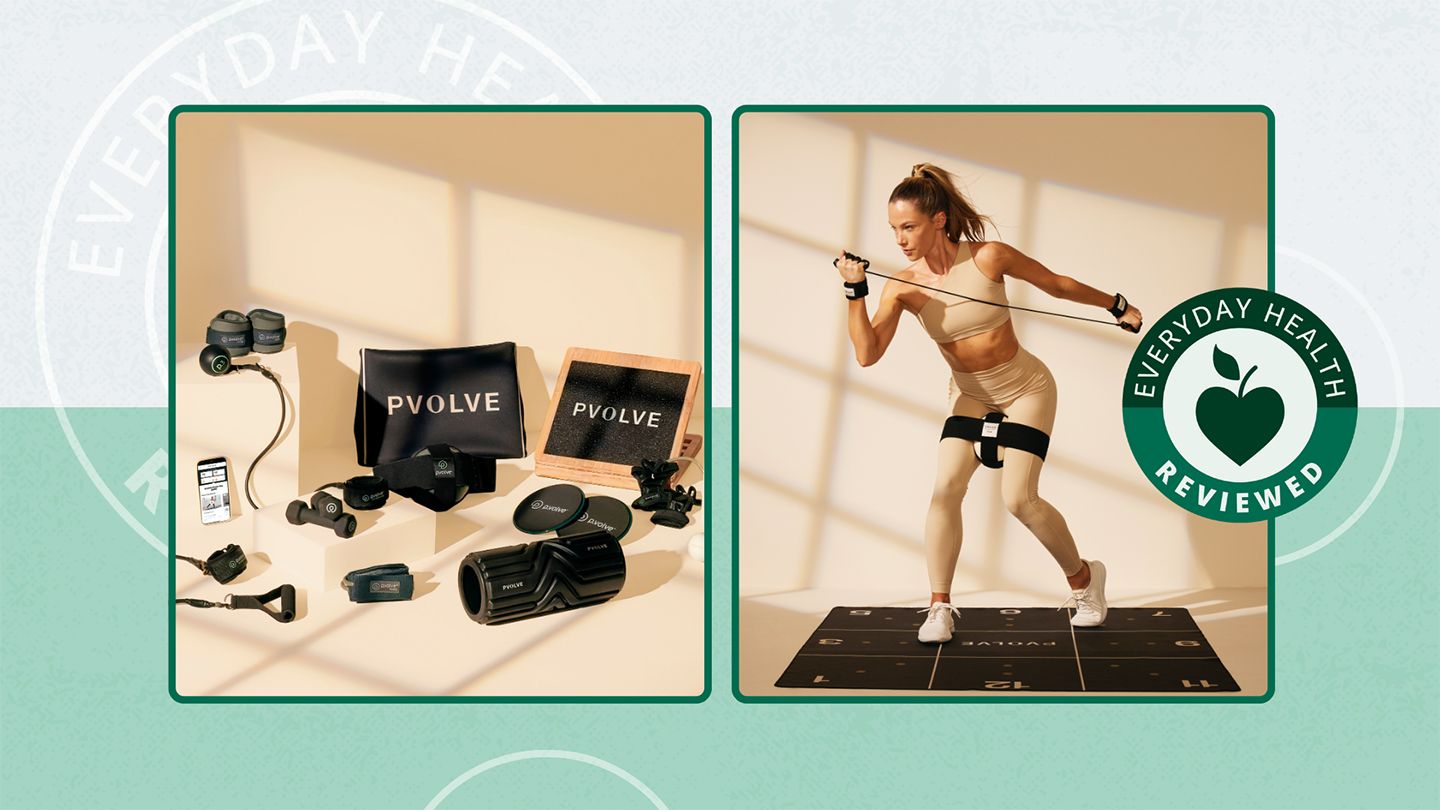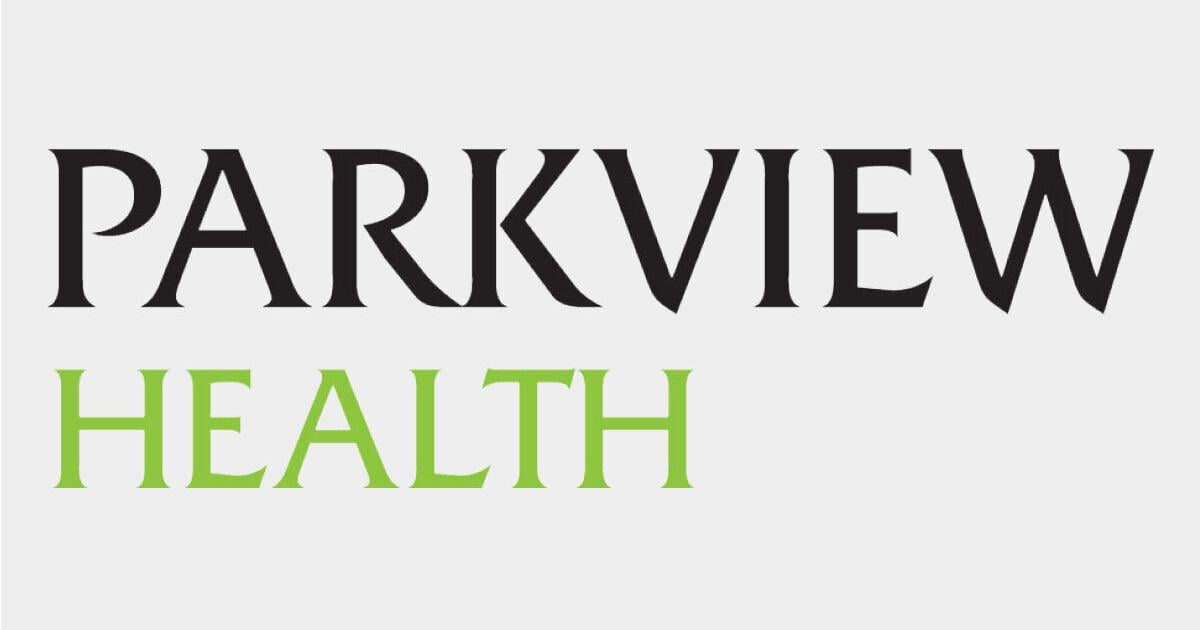Pvolve provides a plethora of benefits such as strengthening and sculpting, improving mobility and balance, increasing mind-body connection, and increasing flexibility.
Pvolve
“Functional strength training stimulates muscle growth and increases bone density, whilst movements that work joints through their full range of motion help to maintain mobility,” says Tom Berry, a certified personal trainer, sprint and hurdles coach at the University of Exeter in England, and the owner of To Be Personal Training. “In addition, slow and controlled movements, encouraging awareness of the body, will improve balance.”
In short, Pvolve trains you to move well and age gracefully.
Pvolve May Help Stave Off Age-Related Muscle Loss — and Even Increase Strength
Research shows that age-related decreases in muscle mass and strength starts in our forties for men and women; most troubling is that research shows a decline in both with each passing year. According to Pvolve’s healthy aging clinical study, 70 women ages 40–60 who completed Pvolve workouts several days a week for three months showed a 20 percent improvement in muscle strength and function compared with the control group that followed the guidelines of 150 minutes of moderate aerobic activity and two strength training sessions per week recommended by the Centers for Disease Control and Prevention (CDC) and the American College of Sports Medicine (ACSM).
Pvolve May Be Particularly Beneficial to Menopausal Women
“During the menopause transition, our bodies start to lose muscle mass through a natural process called sarcopenia, at about 3–8 percent per decade,” says Vicario. To offset this, Vicario recommends weight and resistance training. “Muscle is key for keeping our metabolism optimized for healthy body composition, slowing bone loss, combating insulin resistance, and helping us maintain good musculoskeletal health,” she adds.
Mobility training can also keep our joints lubricated and healthy.
“Loss of estrogen [during and after menopause] also impacts our connective tissue, as estrogen helps us maintain elasticity and hydration in these tissues,” says Vicario. “Mobility training should be prioritized during this life stage. Hip strength and function is especially important, as one in three women will fall and have a fracture after the age of 50. Training lower body strength, mobility, and stability proactively protects our movement longevity.”
Pvolve Provides a Holistic Approach to Fitness
 Pvolve
Pvolve
The balance and stability challenges require you stay lifted and braced through the core and not sinking into your anchored leg, otherwise you may risk collapsing. This mind-body connection trains you to stay present and aware of changing conditions.
“This focus on mind-body connection can have therapeutic implications for individuals dealing with pain or chronic health issues. By promoting mindfulness during exercise, Pvolve encourages users to be present and attentive to their bodies, fostering a positive relationship with movement and potentially contributing to the mental and emotional well-being of individuals facing health challenges,” says Cunningham.
“Through practices such as breathwork, intentional movement, and focused attention on muscle engagement, Pvolve’s workouts not only strengthen the body but also cultivate a sense of self-awareness and mindfulness that can be empowering and transformative for individuals navigating chronic health conditions or pain,” continues Cunningham.
Pvolve Is Adaptable to Nearly All Levels, Abilities, and Conditions
“By focusing on controlled movements and proper body alignment, Pvolve aims to reduce stress on joints and muscles, making it accessible to a wider range of individuals, including those dealing with chronic health issues,” says Cunningham. “This emphasis on joint-friendly exercises not only minimizes the risk of exacerbating existing conditions but also allows individuals to engage in regular physical activity without fear of discomfort or injury, thereby supporting long-term adherence to a fitness routine.”
Chris Pruitt, a certified personal trainer and CEO of Workout Healthy, says Pvolve’s low-impact exercises reduce risk of injury, which can be particularly beneficial to beginners, older individuals, or those recovering from an injury. “Pvolve’s adjustable resistance and joint-protective exercises improve flexibility and reduce discomfort, making them beneficial for people with chronic conditions or limited mobility,” he adds.
 Pvolve
Pvolve
“While designed to be inclusive, individuals with certain health conditions should consult their healthcare provider before starting,” advises Pruitt. “Those requiring high-intensity cardiovascular training for specific fitness goals may need to supplement with additional exercises.”
Vicario promises that Pvolve will meet you where you are. The Moving Stronger program, available through the streaming service, is a 12-class series geared toward an audience age 60-plus that’s designed to encourage better hip mobility, balance, posture, and strength. The platform also includes the Movement Therapy series, which addresses common injuries and movement limitations with physical therapy-inspired exercise routines.
Pvolve May Improve Body Composition
“The [healthy aging] study also highlighted increases in lean muscle mass without accompanying weight gain, indicating a positive shift in body composition,” says Nima Alamdari, doctor of physiology and Pvolve clinical advisory board member.
Pvolve Improves the Balance and Mobility We All Need to Avoid Falls
A review of 34 studies showed that 25–35 percent of those age 65 and up experience falls each year that may lead to adverse health effects like hip fractures, brain damage, disability, decreased mobility, and anxiety.
In Pvolve’s healthy aging study, the 20 percent improvement in strength and function, “correlated with approximately a 10 percent improvement in lower body balance and mobility, along with a 20 percent improvement in flexibility,” Dr. Alamdari says. “These improvements are particularly significant, as they contribute to a reduced risk of falls in later life.”
The Pvolve method includes balance and stability work as well as motions performed at different speeds — slowly lowering in a side lunge and quickly bounding off the leg and holding it aloft, for example. When we lose balance, we fall quickly, and training the body to stabilize during sudden shifts can help, “sharpen the neuromuscular system and build better overall stability to protect against falls,” says Vicario.




